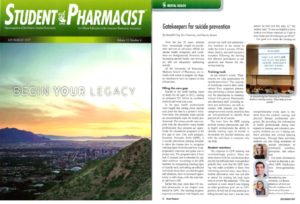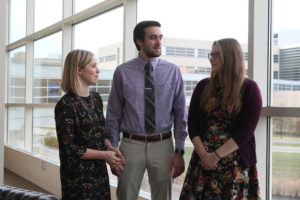By Katie Ginder-Vogel
As the health professional many people see most regularly, pharmacists are often on the front lines when patients are struggling. Three third-year UW–Madison School of Pharmacy students, Meredith Frey, Marnie Janson, and Eric Friestrom, have created an on-campus training program to teach pharmacists to identify and appropriately help potentially suicidal patients, using the Question, Persuade, Refer (QPR) framework for suicide prevention.
Casey Gallimore, associate professor in the Pharmacy Practice Division, put the three PharmD students in contact with each other, and the students began working together to bring the QPR suicide prevention training to the UW–Madison School of Pharmacy.
“Suicide prevention is such a vital topic,” says Gallimore. “As accessible members of the health care team and empathetic citizens, it is crucial that pharmacy students and pharmacists develop skills around suicide prevention. The QPR training provided a first step in helping our students, faculty, and staff to achieve this.”
The training was a collaboration with other pharmacy student organizations—the Wisconsin Society of Pharmacy Students (WSPS) and the Psych and Neuro Special Interest Group (SIG)—with Frey, Janson, and Friestrom acting as the driving forces.
Shared mental health interest
Frey had been focused on finding a way to train student pharmacists to recognize the signs of suicide risk in patients since she completed her QPR training online in July 2016.

“I realized it wasn’t something people knew about and wanted to bring it to more people,” says Frey. “We’re going to be everywhere—different settings, including outpatient settings. Pharmacists will see patients more than anyone. If we can identify the warning signs of suicide and know how to intervene, we can make a big impact on patients, our community—really anyone.”
Friestrom had always been interested in mental health and psychiatric pharmacy, so he helped start a group on campus to let PharmD students explore those issues together.
“When we sat down in that group and talked about what to accomplish as a group this year, multiple students brought up suicide prevention training,” Friestrom says.
Janson had taken suicide prevention training as a member of the undergraduate student government at Ohio State. As a representative to the WSPS student organization, she wanted to make her fellow student pharmacists more aware of mental health issues.
“Increasing awareness decreases the stigma of depression, and training student pharmacists to recognize the signs and symptoms of depression and suicidal ideations is really important,” says Janson. “Health care providers have the knowledge and tools to prevent suicide.”
Training for the School
A classmate put Janson in touch with Jean Papalia, a retired police officer who trains police in suicide prevention, who donated her time to provide the QPR training to the School of Pharmacy. More than 150 students, faculty, and staff attended the training at the School of Pharmacy in January 2017.
“Jean brought in handouts and booklets for students to reference,” says Janson. “She was amazing and really engaged the students to make it enjoyable. It was a really good training session.”
“If we can help patients, or even just our classmates, that’s a big deal. We’re socialized to not talk about mental health, so this breaks down those barriers.” –Marnie Janson
Frey felt the QPR training was even more impactful the second time around.
“Having a person there to train you face-to-face with a group of your peers, talking about something pretty heavy, instead of just completing modules online, makes you think about why you’re there and what you can take away from that,” says Frey.
Frey, Friestrom, and Janson set up a post-training debriefing session to give people the opportunity to talk about their experiences.
“I think that was a really good way to keep it going outside the one-hour training session,” says Friestrom. “It kept people involved and allowed them time to reflect on the meaning of the training and their takeaways. These are our peers, with whom we’ve grown and struggled, so that was meaningful.”
The three will offer the suicide prevention training again this spring, after spending the fall semester setting up the program, so that it can be offered annually to School of Pharmacy students, faculty, staff, and community members.
Getting published

For greater awareness, Janson submitted the trio’s article on the QPR training at UW–Madison to Student Pharmacist, a publication of the American Pharmacists Association (APhA). It was published in the July/August issue of the magazine.
Following the article’s publication, at a recent conference focused on pharmacy policy, a team from the University of Michigan referenced their article in a proposal on incorporating suicide prevention training into pharmacy school curriculum nationwide.
At the same conference, representatives from other pharmacy schools who had read the article and were interested in replicating the model approached Janson and Friestrom to learn more about how they planned the QPR training at UW–Madison.
Positive impact from outreach
There have been other positive stories directly resulting from the training. Janson, who ultimately hopes to work as a community pharmacist or specialize in psychology and psychiatry, told a colleague at the local pharmacy where she works about the QPR training.
Shortly thereafter, that pharmacist asked a patient struggling with chronic pain and opioid dependency about suicide. Following their conversation, the patient called to tell the colleague that he had indeed been contemplating suicide and was glad she had asked him about it, telling the pharmacist, “You made a difference.”
“Pharmacists are the most trusted health care providers,” says Janson. “If we can help patients, or even just our classmates, that’s a big deal. We’re socialized to not talk about mental health, so this breaks down those barriers.”

In another case, a student who hadn’t been able to attend the training, but had read the materials, shared that the information had prepared her to address a situation in which a patient confessed suicidal thoughts. She was able to intervene appropriately and help the patient.
“It’s important to be able to identify a situation, know what actions to take, and know how to refer someone for help,” says Friestrom, who plans to explore specialties in psychiatric pharmacy and mental health, possibly as a hospital pharmacist.
“It’s like CPR; everyone knows you should know it, but if you haven’t learned it, you can’t address a situation. We prepare people before they’re presented with a situation. Even that one outcome was so worth that training.”
Friestrom notes that the stigma of mental illness can make people reluctant to address the prevalence of suicide and the importance of suicide prevention training. In Wisconsin, the suicide rate is four times the homicide rate.
“The statistics, in my eyes, are mind-blowing, and if you take a group of 150 people and apply those statistics to that group, it becomes really clear how prevalent suicide is and how important it is to know what to do,” says Friestrom. “An hour and a half spent in suicide prevention training can have a true impact on somebody’s life.”
The community outreach efforts by Frey, Friestrom, and Janson are impressive in the team’s initiative and drive.
“I am so proud of Marnie, Meredith and Eric for formulating this idea, developing and organizing it, and seeing it through to fruition,” says Gallimore. “It speaks volumes to their ambition and illustrates how UW–Madison School of Pharmacy students are fostering the Wisconsin Idea through purposeful action—engaging in public service, partnering with others, contributing to community, and leading positive change.”